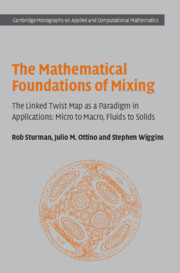 The Mathematical Foundations of Mixing
The Mathematical Foundations of Mixing Book contents
- Frontmatter
- Contents
- Preface
- Acknowledgments
- 1 Mixing: physical issues
- 2 Linked twist maps: definition, construction and the relevance to mixing
- 3 The ergodic hierarchy
- 4 Existence of a horseshoe for the linked twist map
- 5 Hyperbolicity
- 6 The ergodic partition for toral linked twist maps
- 7 Ergodicity and the Bernoulli property for toral linked twist maps
- 8 Linked twist maps on the plane
- 9 Further directions and open problems
- References
- Index
4 - Existence of a horseshoe for the linked twist map
Published online by Cambridge University Press: 03 February 2010
- Frontmatter
- Contents
- Preface
- Acknowledgments
- 1 Mixing: physical issues
- 2 Linked twist maps: definition, construction and the relevance to mixing
- 3 The ergodic hierarchy
- 4 Existence of a horseshoe for the linked twist map
- 5 Hyperbolicity
- 6 The ergodic partition for toral linked twist maps
- 7 Ergodicity and the Bernoulli property for toral linked twist maps
- 8 Linked twist maps on the plane
- 9 Further directions and open problems
- References
- Index
Summary
The underlying structure of complicated behaviour in the linked twist map is that of the ‘Smale horseshoe’. This chapter contains a detailed construction of the horseshoe, and the implications of its existence for symbolic dynamics.
Introduction
The main goal of the mathematical sections of this book is to show that linked twist maps have the Bernoulli property on all of their domain (except for possibly a set of measure zero). Before discussing the theory that will be necessary to attack this problem, we start with an easier, preliminary result. Namely, we give Devaney's proof of a theorem that a linked twist map has a Smale horseshoe (Devaney (1978)). This is a somewhat ambiguous, albeit commonly used statement in the literature. The Smale horseshoe map is a homeomorphism (it need not be area preserving) having the property that it has an invariant set on which the map is topologically conjugate to the Bernoulli shift, i.e., it has the Bernoulli property on an invariant set. A slight confusion may arise since occasionally the invariant set itself is referred to as the horseshoe. Smale horseshoe (or just “horseshoe”) maps are ubiquitous in the sense that they can always be constructed near transverse homoclinic points. This is the content of the Smale–Birkhoff homoclinic theorem. All of this is described in detail, and from an elementary point of view, in Wiggins (2003).
- Type
- Chapter
- Information
- The Mathematical Foundations of MixingThe Linked Twist Map as a Paradigm in Applications: Micro to Macro, Fluids to Solids, pp. 105 - 125Publisher: Cambridge University PressPrint publication year: 2006


